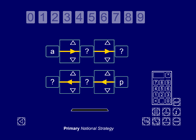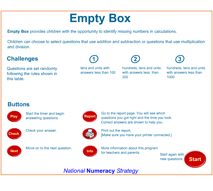Consolidation and practice
These resources are to support children in guided or independent work. Roll over the highlighted resources for a description.
Function blocks

This interactive teaching program (ITP) is an ICT-based tool to support the exploration of calculation and inverses. Function blocks ITP allows the child or teacher to display and explore the effect of up to three operations on a starting or finishing number. The keypad can be used to input decimal numbers, and two rows of function machines can be displayed to compare the effect of using different input values, order or type of operations.
Empty box program

This ICT-based tool can be used by children to practise and consolidate multiplication, division, addition and subtraction, and to develop understanding of inverse operations and when not to use a calculator. Different activities, numbers of questions and operations can be selected to vary the level of challenge.
Opportunities to use and apply
Confirming learning
Ask probing questions such as:
- I think of a number, divide it by 3 and add 11. I get the answer 21. What number did I think of?
- Becky buys 3 milkshakes. She pays with a £5 note and gets 35p change. How much does each milkshake cost? Draw a function machine to represent the process you went through to find your answer.
- What number when multiplied by 4 gives itself plus 60?
- Ricky is at school from 8:40 am to 3:15 pm. He has 20 minutes registration, 25 minutes break and 50 minutes for lunch. The rest of the school day is organised into 6 equal lessons. How long is each lesson?
 + 15 = 25 × 5
+ 15 = 25 × 5 × 4 − 19 = 5
× 4 − 19 = 5 Calculating
Calculating

